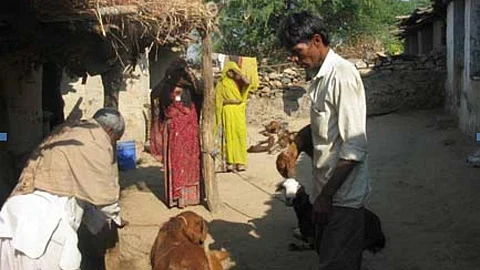
- Topics
- Feature
- Opportunities & Events
- About
- Hindi Portal
- Data
- Topics
- Feature
- Opportunities & Events
- About
- Hindi Portal
- Data

Pastoralist communities are those that depend primarily on livestock (domesticated animals in an agricultural setting) for their living. India has the world’s highest livestock population with 440 million livestock heads distributed over 100 million households (1) but in recent years, pastoralists have been facing threats to their way of life. At no other time in the past have these communities been fenced off and evicted to this extent from lands that legally and traditionally belonged to them.
There have been dramatic changes in livestock population and composition over the past five decades, many of which have negatively impacted the poor (1). In fact, post 1990, the rate of decadal loss of common lands on which the pastoralists depend has grown from the 20% to as high as 40%, said Dr. Sagari Ramdas (2), an expert on the subject at a public lecture in New Delhi recently.
Within the small ruminants, goats have been adversely affected in most places. I met a couple of herders/ shepherds and groups representing their interests during my visits to Chittoor district of Andhra Pradesh some time back. Most of the shepherds were into settled agriculture, and had given up their nomadic lifestyle. They combined this with wage labour work and sheep rearing. The gollas and kurubas constitute the main livestock owning castes in this area. Gollas keep all types of livestock while kurubas have historically been into sheep and goat rearing.
Occupational patterns have since changed and they are now engaged in diverse activities like agricultural labour, petty shopkeeping and farming. Ramana lives in Kantavaripalli village in Chittoor. His grandparents used to migrate from January to June with their sheep to nearby areas in the range of 40-50 kms towards high rainfall areas. After returning they used to practice agriculture for three to four months.
But the decline in la
nds available as pastures forced Ramana to get out of nomadic pastoralism and move into settled agriculture. A kuruba by caste, he has poor quality slopy lands that he received as a part of land distribution from the state. Ramana used to keep mostly goats earlier but has shifted to sheep in the last few years due to restrictions in grazing. Also, "stall-feeding of small ruminants tends to be less viable than with large ruminants". [Conroy, 2004].
The Forest Protection Committee - Vana Suraksha Samiti (VSS) had restricted grazing in the Horseley Konda Reserved Forest after treating the area. The area was legally open to goats earlier in lieu of some bribe either in the form of cash or a few goats a year to the Forest Department. There has been a severe reduction in the number of goats kept in the village and most of the people from the kuruba caste have shifted to sheep or cattle. No rights are being entertained in the forests and cattle proof peripheral trenches, that bar cattle's entry have been dug up. The Forest Department on the other hand boasts of having increased the area under plantations by twenty five times in the forests nearby in the last decade.
The implications for the poorer section of the village have been severe as the decision-making powers have been vested in the hands of the Forest Department and /or the Van Suraksha Samiti (VSS) Chairperson. The graziers and herders are required to obtain grazing permits from the Foresters and the VSS Chairman, thus resting unlimited powers in their hands. The tension between livestock rearing practices and the anti-poor and anti-goat ‘forest management’ continues.
As a consequence, groups like these are increasingly going to Court against the Central and State governments to defend their rights to the pasturelands.
In Karnataka, the Amrit Mahal Kaval lands in Challakere taluka of Chitradurga district, was in the headlines recently. The area lies in the Deccan plateau, which is home to traditional pastoralist communities like – the dhangars, kurubas and gollas. These pastures rich in biodiversity not only supported the lives of the pastoralists but were also home to the highly threatened blackbuck and Great Indian Bustard. The State Government had tried to shift 4,047 hectare lands in these 73 villages to various defense, industrial and infrastructure projects.
Thousands of villagers belonging to the area protested the move. They asserted that they had been undertaking grazing practices that prevented excessive overgrazing. The diversion contradicts the various policies of the Central Government that seek to protect grasslands and livelihoods of pastoralists. Public Hearings were not conducted and nor was consent of the local bodies (Gram Panchayat) taken.
The Bangalore-based advocacy group, Environment Support Group (ESG) alleged that the Karnataka Government comprehensively violated various forest, biodiversity and environmental protection laws while diverting these lands. ESG put up an application to the National Green Tribunal (NGT) pointing out the violations. The NGT has in a proactive decision halted the move.
Policy cannot be formulated in an undemocratic and unilateral manner. The state could do with a greater concern on the rights of poor livestock owners. At present, no consideration is given to the huge diversity of grazing practices and livestock production systems. Institutions like panchayats should play a greater role in negotiating systems to manage the local resources including grazing. The focus ought to be not only on forests but also on other farm and pasture-based fodder sources.
(1) Sagari Ramdas and Nitya Ghotge, India’s livestock economy, Seminar, 2010
(2) Anthra is a Hyderabad based NGO working with pastoral groups in the country.